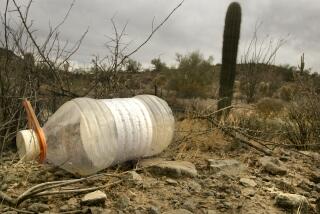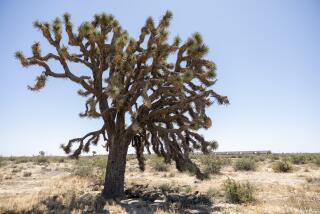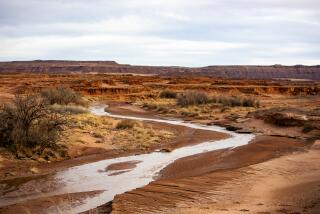Wildlife thirst aid challenged
After decades of losing their natural watering holes to dams and diversions, many thirsty desert animals have found an oasis in “guzzlers,” but conservation groups clash over whether the man-made troughs help or harm wildlife.
As he gazes into a stagnant cistern notched into the Orocopia Mountains east of Indio, Leon Lesicka, a hunter and water sources coordinator for Desert Wildlife Unlimited, points out quail bobbing nearby and bighorn sheep droppings. He sees the guzzler, an artificial watering hole that his group installed, as reparation for concrete-lined canals and freeways.
Next to Lesicka stands Elden Hughes, chairman of the Sierra Club’s desert committee, who says guzzlers upset an already traumatized ecosystem. He says they should be used only in places where animals might otherwise wander into irrigation channels and across highways in search of water. “Most of the guzzlers are there to increase herds for hunting,” he says. “It is game farming.”
With a smile and a shrug, Lesicka agrees. “I can’t argue with you . We now don’t lose deer in the canal. The deer herd is healthy, and people are hunting them,” he says. “I think that goes hand in hand with saving deer and sheep.”
Brawley-based Desert Wildlife Unlimited formed in 1980 after 200 deer drowned in a concrete-lined portion of the Coachella canal near the Salton Sea. Some survivors wore out their knees and hoofs trying to escape, Lesicka says.
The group, which today includes 400 hunters and other wildlife enthusiasts, has installed more than 100 guzzlers in the Southwest. Volunteers work with state agencies and the federal Bureau of Land Management to secure permits and sites. Some guzzlers are fiberglass; others are concrete. The big ones collect rainfall behind a dam, divert it into a trough and store the excess water in twin 6,000-gallon tanks.
Once eager to build guzzlers, Hughes, along with other environmentalists, now says they do more harm than good. The critics say guzzlers attract mountain lions, which ambush thirsty bighorn sheep, as well as ravens, which prey on juvenile desert tortoises. They also attract masses of honeybees that crowd out other pollinating insects.
Meanwhile, several animal drownings have prompted officials to scrutinize guzzlers.
After reports of desert tortoise drownings, state officials retrofitted some bird guzzlers to keep out the stumpy-legged reptiles, says Nancy Andrew, wildlife biologist for the Department of Fish and Game.
The rotting carcasses of drowned bighorn sheep in a large cistern in the east Mojave poisoned several dozen other sheep nine years ago. However, a study found that sheep sometimes die of botulism after drinking contaminated water at some natural sources as well, says Vern Bleich, a senior environmental scientist for the Department of Fish and Game and leader of the Sierra Nevada Bighorn Sheep Recovery Program.
Steve Rosenstock, a research biologist with Arizona’s Game and Fish department, says his tests of guzzler water samples conducted over three years in the Southwest revealed no significant levels of contaminants. He says water quality in guzzlers is similar to that in livestock tanks.
Indeed, Rosenstock says man-made water sources are essential in desert lands desiccated by dams, water diversions and, increasingly, global warming.
“The reality is that we have modified the environment so much that we can’t go back to that Garden of Eden, that mythical state where we step away from things and it all takes care of itself,” he says.
More to Read
Inside the business of entertainment
The Wide Shot brings you news, analysis and insights on everything from streaming wars to production — and what it all means for the future.
You may occasionally receive promotional content from the Los Angeles Times.










